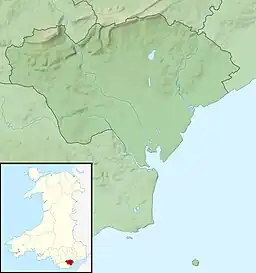Morganstown Castle Mound
Morganstown Castle Mound, also known as Morganstown Motte, is a medieval motte in the community of Morganstown in Cardiff, Wales, which is a scheduled monument.[1]
| Morganstown Castle Mound Morganstown Motte | |
|---|---|
 The overgrown Morganstown Castle Mound | |
| Type | Motte-and-bailey castle[1] |
| Location | Morganstown, Cardiff, Wales[1] |
| Coordinates | 51.528960°N 3.258213°W |
 Morganstown Castle Mound Location in Cardiff | |
| Official name | Morganstown Castle Mound[1] |
| Designated | 29 May 1958[1] |
| Reference no. | GM256[1] |
History
Motte-and-bailey castles date back to the medieval period, from 1066 to 1540 AD.[1] Recently a broken piece of French polychrome pottery ware was found on the site. There is no record of the motte as to its exact age, although as with other mottes in the north of Cardiff, such as Treoda Castle Mound and Twmpath Castle, it is believed that it was established between the late 11th century and early 12th century.[2]
Present day
The motte is a large mound of soil and/or stone and stands from 4 meters (13 ft) high with steep sides and a flat top from 14 meters (46 ft) in diameter and a base of 30 meters (98 ft) diameter.[1][3] The tower on the motte would have been constructed out of either timber or stone.[1] The motte is surrounded by a ditch which was either a wet or dry ditch and 6 meters (20 ft) wide with an outer bank from 1 meter (3.3 ft) high and 2.5 meters (8.2 ft) wide. The site is now overgrown with trees and shrubs.[2]
Cadw has described the monument as being of "of national importance for its potential to enhance our knowledge of medieval defensive practices. The monument is well-preserved and an important relic of the medieval landscape. It retains significant archaeological potential, with a strong probability of the presence of both structural evidence and intact associated deposits. The scheduled area comprises the remains described and areas around them within which related evidence may be expected to survive."[1]
See also
References
- Cadw. "Morganstown Castle Mound (GM256)". National Historic Assets of Wales. Retrieved 2022-06-05.
- An Inventory of the Ancient Monuments in Glamorgan: Volume III: Medieval secular monuments. The early castles - from the Norman Conquest to 1217: Volume III: Medieval secular monuments. The early castles - from the Norman Conquest to 1217. 1991. p. 58. ISBN 978-0-11-300035-7. Retrieved 5 June 2022.
{{cite book}}:|work=ignored (help) - "Morganstown Motte". Royal Commission on the Ancient and Historical Monuments of Wales. Retrieved 5 June 2022.
External links
 Media related to Morganstown Castle Mound at Wikimedia Commons
Media related to Morganstown Castle Mound at Wikimedia Commons- Images of the Morganstown Castle Mound from the RCAHMW